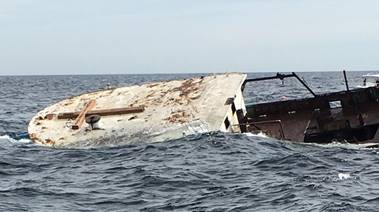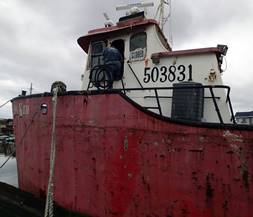Two More Vessels Being Sunk as Part of Revitalized Artificial Reef Program
(16/P87) TRENTON – The Department of Environmental Protection’s artificial reef program is sinking two more vessels to enhance recreational fishing opportunities and enhance ocean habitat for fish.
The program, back in gear following restoration of federal funding, sank the 68-foot trawler, Austin, today as part of the Axel Carlson Reef, 4.4 nautical miles southeast of Manasquan Inlet.
The 115-foot surf clam vessel, Lisa Kim, is scheduled to be sunk as part of the Wildwood Reef, 8.3 miles northeast of Cape May Inlet this Friday, weather permitting.
 The boats are among as many as 10 vessels the DEP’s Division of Fish and Wildlife plans to deploy by the end of fall.
The boats are among as many as 10 vessels the DEP’s Division of Fish and Wildlife plans to deploy by the end of fall.
After a hiatus of nearly five years, three vessels were deployed over the summer. The sinking of these vessels was made possible by an agreement reached by the Christie Administration regarding access to reefs by recreational and commercial fishing interests that resulted in restored federal funding for the artificial reef program.
“For more than 30 years, New Jersey has had a robust program of creating artificial reefs that enhance offshore habitats for fish and draw in thousands of anglers and sport divers,” said DEP Commissioner Bob Martin, who was on-hand for today’s sinking of the Austin. “These latest additions continue that tradition and firmly establish the program as being back in business.”
The U.S. Fish and Wildlife Service is providing $119,250 to the artificial reef program because the DEP was able to reach a compromise that allows commercial interests to have continued access to portions of two reefs in state waters and calls for the construction of a new reef for recreational fishing, also in state waters. State waters extend three miles from the shoreline.
The U.S. Fish and Wildlife Service had suspended the funding due to concerns that commercial fishing was intruding on and hampering recreational  fishing on artificial reefs in state waters, which are funded by excise taxes on recreational fishing gear and motor boat fuel. The compromise was reached in 2013, and codified in rule changes that were adopted by the DEP in November 2015.
fishing on artificial reefs in state waters, which are funded by excise taxes on recreational fishing gear and motor boat fuel. The compromise was reached in 2013, and codified in rule changes that were adopted by the DEP in November 2015.
Under the new rule, commercial fishing operations are permitted to continue using portions of two existing reefs in state waters off Sandy Hook and Manasquan. State waters extend to three miles offshore. Recreational anglers will continue to have access to all portions of these reefs.
artificial reef structure materials attract the most fish.
Among the vessels expected to be deployed before the end of the year is the former U.S. Coast Guard Cutter Tamaroa immortalized in the book The Perfect Storm and the movie by the same name for its rescue role during a brutal nor’easter in 1991. Originally a U.S. Navy fleet tug, the Tamaroa is also the last surviving vessel from the World War II Battle of Iwo Jima.
Old vessels and other materials used in artificial reefs provide surfaces for organisms such as algae, barnacles, mussels, sea stars, and sea fans to grow on. This colonization occurs in as little as two weeks. These organisms attract smaller fish which, in turn, attract black sea bass, tautog, summer flounder, scup, lobster and other sought-after species.
Artificial reefs are extremely popular with anglers and divers, contributing to the state’s economy through the creation of tourism opportunities and jobs. New Jersey’s commercial fishing industry ranks 7th in the nation in retail sales, and supports $327 million in salaries and wages and nearly 13,000 jobs.
Recreational saltwater fishing brings in more than $640 million in retail sales and is directly responsible for nearly 10,000 jobs and more than $242 million in tax revenues, including $165 million in state and local taxes.
For more information on New Jersey’s Artificial Reef Program, visit: http://www.nj.gov/dep/fgw/artreef.htm
For related DEP news releases, visit: http://www.nj.gov/dep/newsrel/2016/16_0074.htm
www.nj.gov/dep/newsrel/2015/15_0100.htm, www.nj.gov/dep/newsrel/2013/13_0025.htm and www.nj.gov/dep/newsrel/2015/15_0012.htm
Photos/Top: Trawler Austin; Bottom: Clam boat Lisa Kim